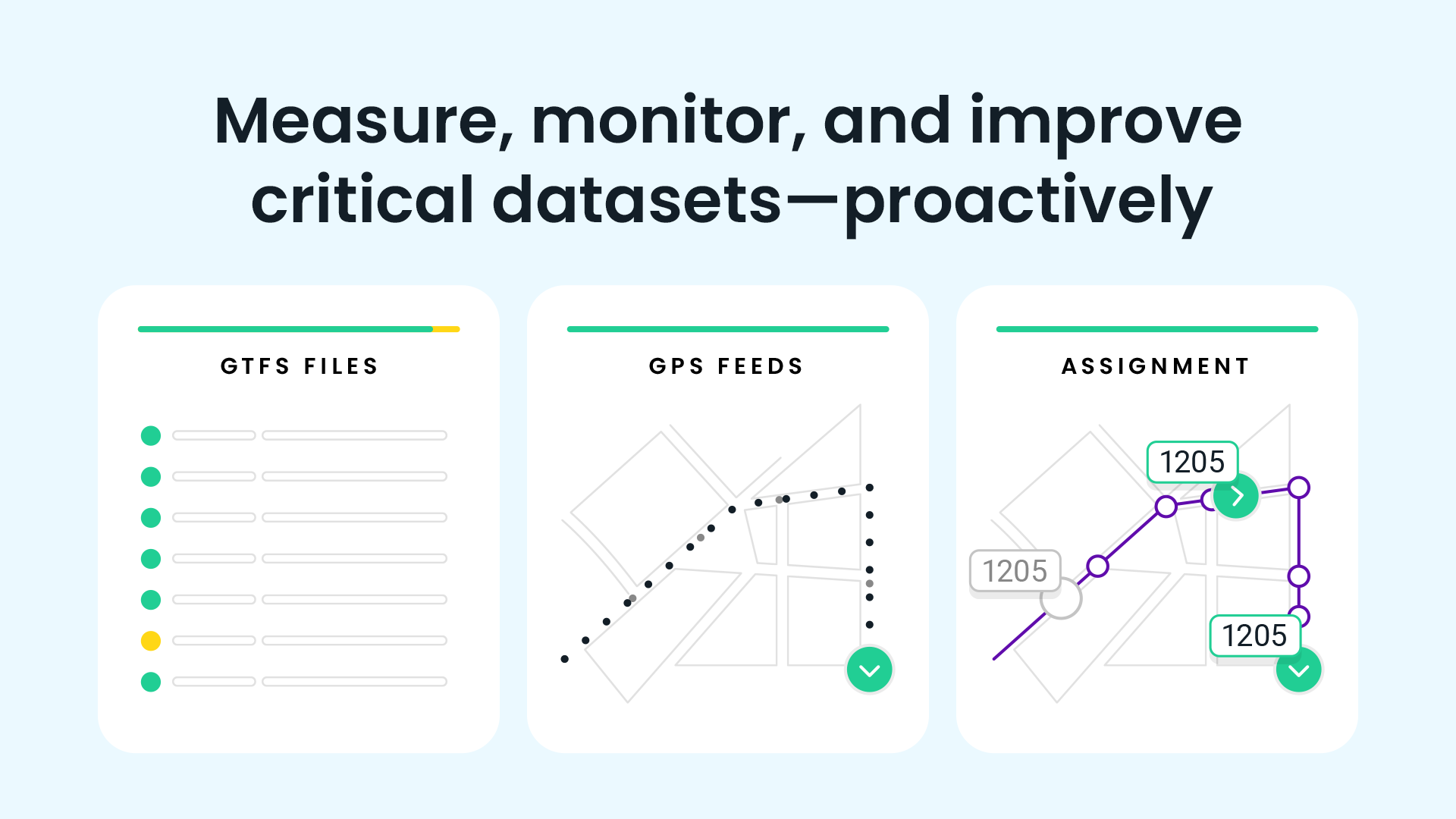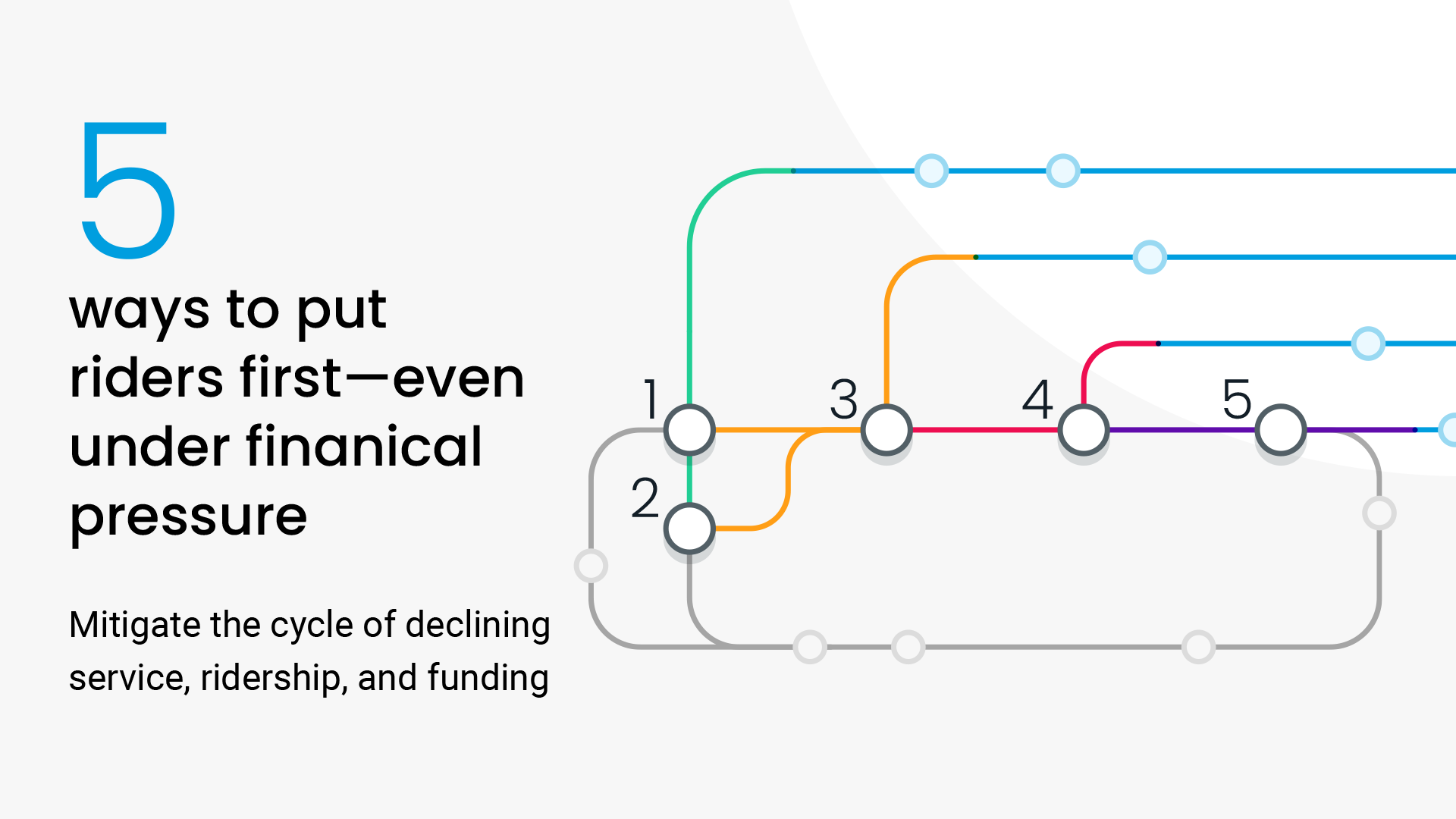
November 14, 2024
Accurate, actionable OTP reporting: New tools and best practices

November 14, 2024
Accurate, actionable OTP reporting: New tools and best practices
November 14, 2024
Accurate, actionable OTP reporting: New tools and best practices
On-time performance is the standard industry metric for reporting and assessing service reliability. However, there is a large gap between data that meets basic board reporting requirements and data that allows planning, scheduling, and operations staff to quickly monitor and refine transit service.
Swiftly works with agencies of all sizes to report on service performance. Through this work, we have identified trends in how agencies can successfully measure on-time performance and deliver actionable insights to staff. We also continue to evolve our transit data platform to provide a better understanding of how service performance impacts riders—including a new feature that we’re thrilled to announce today.
Read on for best practices for agencies to measure service performance and take action to improve their results.
New: Understand on-time performance alongside service delivery
At Swiftly, we’re constantly looking for ways to surface new, valuable data and more accurately align performance metrics with the passenger experience.
Today, we’re excited to unveil new features to Swiftly’s On-Time Performance product that give operations and planning teams better insights into how system performance impacts riders.
Viewing on-time performance in isolation only offers information on stops that were observed. There are still key elements of the passenger experience that a standard on-time performance report doesn’t capture:
- Scheduled trips that were canceled without communication to riders (a “ghost bus”)
- Incomplete trips that ran but missed some stops without communication to riders
- Trips that were canceled or modified with communication to riders
- Trips that ran but did not provide real-time passenger information due to technical problems (a "zombie bus")
Swiftly’s new Data Completeness report gives a holistic view of the rider experience across on-time performance, service delivery, and data availability. With this data, agencies can understand on-time performance within the larger context of observed and missed service.

This new data insight shows the total number of scheduled stops and the percent that were on-time, early, late, communicated, or missing. For the first time, agencies can understand the scale of missing service alongside on-time performance data, giving complete visibility into the rider experience.
With the Data Completeness report, agencies can prioritize challenges to service reliability and rider communications. A best practice for agencies looking to improve their results from the report is to communicate disruptions to reduce the prevalence of missed service and “ghost bus” experiences. Through integration with Swiftly’s Service Adjustments, agencies can not only communicate disruptions with staff and riders but also see the percentage of service that has been communicated in the Data Completeness report. Now agencies using On-Time Performance for reporting and Service Adjustments for managing disruptions can track their progress towards eliminating missed service.
5 best practices for measuring on-time performance
1. Reporting based on high-quality data
On-time performance reporting can only be as accurate as the underlying data. Our team frequently conducts “data therapy sessions,” where Swiftly experts diagnose missing or inaccurate reporting data. From this practice, we’ve identified common shortcomings that result in misleading on-time performance figures.
To start, we often hear from agencies that lack confidence in their reporting due to missing or inaccurate automatic vehicle location (AVL) data. Outages and slow vehicle location reporting rates can result in imprecise on-time performance data.
Swiftly’s platform can ingest location data from multiple onboard sources, significantly increasing the location reporting rate and producing more accurate on-time performance data. As agencies like County Connection have experienced, Swiftly’s underlying data quality results in reports that can be used for confident decision-making.
“The fidelity of the data improved [with Swiftly]. The other data we received reported every 30–50 seconds, whereas with Swiftly it’s every 5–10 seconds. It’s much more robust. We had more confidence in trying to make improvements with Swiftly data as our baseline.”
—Pranjal Dixit, Manager of Planning, County Connection
Even a high-quality AVL feed can quickly be rendered obsolete if there is no information about what trip or block the vehicle is assigned to. Unfortunately, many agencies encounter assignment issues due to faulty hardware, operator login errors, or delays in loading trip information following a service change.
Swiftly can fix assignment problems through a feature called auto assigner. When assignment data is missing, Swiftly’s algorithms match an unassigned vehicle to a trip, resulting in updated vehicle locations, prediction times, and complete historical data. This results in collecting 10–20% more historical data at stops and timepoints, helping agencies fill in the gaps of their on-time performance reporting.
Another frequent limitation to accurate on-time performance data is a reliance on vehicle geofences.
The arrival and departure times for a vehicle at a stop are the fundamental building blocks of historical data, but often this data is recorded incorrectly. CAD/AVL systems record a vehicle as having arrived or departed when it crosses or “breaks” a geofence (sometimes called a trigger box).
Geofences are notoriously error-prone. For example, if a vehicle departs a stop at 7:00 a.m. but does not break a geofence for an additional 2 minutes (maybe because it is held at a traffic signal) then the vehicle will be recorded as having departed at 7:02 a.m.
A more modern approach applies algorithms to GPS data and historical data to determine the most accurate arrival and departure estimates. The result is on-time performance that is up to 15% more accurate.
Scott Germann, Vice President of Operations for Central Region at Transdev North America shares, “We were experiencing some significant discrepancies in our OTP. Swiftly’s system, which doesn’t require geofencing, showed us numerous areas that needed to be addressed with our current system."
"Wow, what a difference using Swiftly's technology made to understanding and measuring our OTP. I definitely recommend this over traditional geofencing. It’s like driving a 2023 car with loaded tech versus an early 2000s model. What a difference!”
—Scott Germann, VP of Operations for Central Region, Transdev North America
2. Accessible and flexible reports
The speed and ease of data analysis is as important as the data itself. Having accessible reports at their fingertips ensures staff can glean actionable insights independently of data scientists and IT teams. Operations staff can pull up the on-time performance for the entire system or a single route the very same day to understand how weather, traffic, or other events are impacting reliability. Similarly, planning and scheduling can monitor and refine service immediately after a service change instead of waiting several days or weeks. For example, when Miami-Dade Transit executed a historic network redesign, they used Swiftly’s On-Time Performance product to monitor performance for new routes on a daily basis, allowing them to get immediate feedback on the changes.
“The first couple of days of our network redesign, we were monitoring the service and asking, ‘How are these individual routes doing?’ We would see that we’ve increased on-time performance ten points from this previous time. That was a really good, quick, and easy way of checking, ‘Did we get this right?'”
—Linda Morris, Chief of Service Planning, Miami-Dade Transit
Request a demo
3. Measuring data for every stop, not just timepoints
Many agencies say that they are data rich but information poor. Swiftly’s on-time performance reporting not only allows anyone to measure on-time performance, it allows users to diagnose where and when these issues are occurring, which can help get to the root cause of service reliability issues.
It’s difficult to diagnose poor performance on a route with an incomplete picture. That’s the reality of planners and schedulers forced to only look at on-time performance for timepoints, without visibility into the stops in between. Instead, we recommend agencies remain aware of timepoints but also dive deeper to analyze performance for every stop to understand where there are on-time performance issues. We also recommend that agencies dig into on-time performance by time of day to better understand how changes throughout the day, such as traffic, impact on-time performance.
County Connection uses this dataset to pinpoint underperforming sections of routes and make targeted changes to improve results.
“Before Swiftly, we were getting on-time performance data for only scheduled timepoints. With Swiftly, we get more detailed information on how the bus is performing from stop-to-stop, which is a very significant amount of data and is helpful."
—Pranjal Dixit, Manager of Planning, County Connection
"A lot of express routes have very long distances between stops and go through local streets. We didn’t have that data to make changes effectively. With Swiftly, we can analyze it more deeply to see where delays are occurring and make those changes," Dixit continues.
4. Custom definitions for schedule adherence
Individual agencies take slightly different approaches to measuring on-time performance depending on their priorities for addressing early or late departures.
For example, in a recent webinar, Senior Planner Scheduler Chad Johnson of Spokane Transit gave their justification for not allowing any flexibility for early departures.
“We use 0 minutes early and 5 minutes late [to define an on-time vehicle]. When I was an operator, I got dinged for being 30 seconds early. It’s just to make sure that people can catch their buses. This is when we say we’ll be here. If you’re here at this time, we’ll give you a ride.”
—Chad Johnson, Senior Planner Scheduler, Spokane Transit
On-time performance measurement tools must allow for flexible definitions to embrace agencies focusing on their strategic initiatives.
5. Nuanced stop handling to align with industry reporting
For express or commuter routes that handle downtown area stops, an early departure does not negatively impact the rider experience, so many agencies count early departures as on-time or exclude them from their reporting altogether. With the On-Time Performance product, Swiftly can now treat early departures as on-time for stops designated as drop-off-only in an agency’s GTFS file. This allows transit agencies to measure what counts and get a more accurate understanding of their on-time performance.
More accurate data for confident decision-making
The little things add up when it comes to transit data. Many seemingly small factors in how an agency measures on-time performance can be the difference between data that staff are suspicious of and data that can justify major service change decisions. By implementing these capabilities, agencies can achieve accurate on-time performance to serve as a foundation for impactful changes to service reliability.
Want to learn more about how to leverage Swiftly's On-Time Performance product to enhance your agency's reporting and insights? Reach out or contact your Account Manager.
The rich text element allows you to create and format headings, paragraphs, blockquotes, images, and video all in one place instead of having to add and format them individually. Just double-click and easily create content.
Last Name, Agency

What’s a Rich Text element?
What’s a Rich Text element?
What’s a Rich Text element?
What’s a Rich Text element?
What’s a Rich Text element?
The rich text element allows you to create and format headings, paragraphs, blockquotes, images, and video all in one place instead of having to add and format them individually. Just double-click and easily create content.
Last Name, Agency
Static and dynamic content editing
A rich text element can be used with static or dynamic content. For static content, just drop it into any page and begin editing. For dynamic content, add a rich text field to any collection and then connect a rich text element to that field in the settings panel. Voila!
How to customize formatting for each rich text
Headings, paragraphs, blockquotes, figures, images, and figure captions can all be styled after a class is added to the rich text element using the "When inside of" nested selector system.
- text goes here
- text goes here
- text goes here
- text goes here
- text goes here
- text goes here









